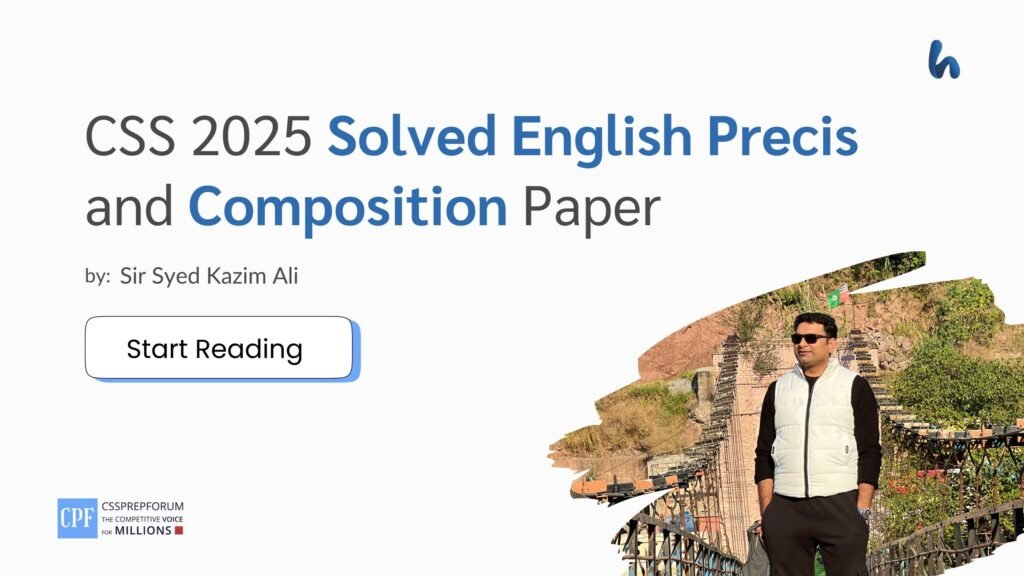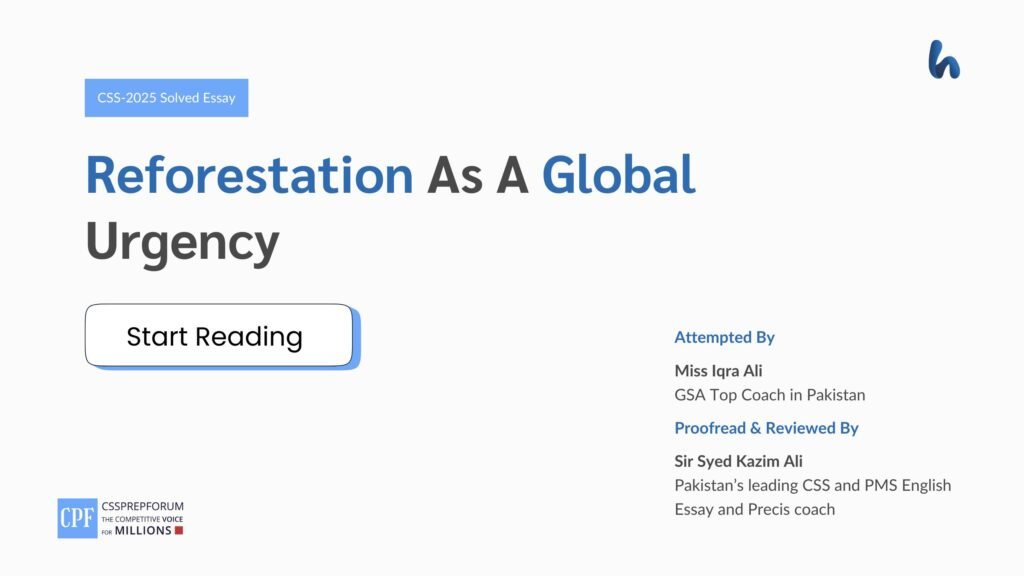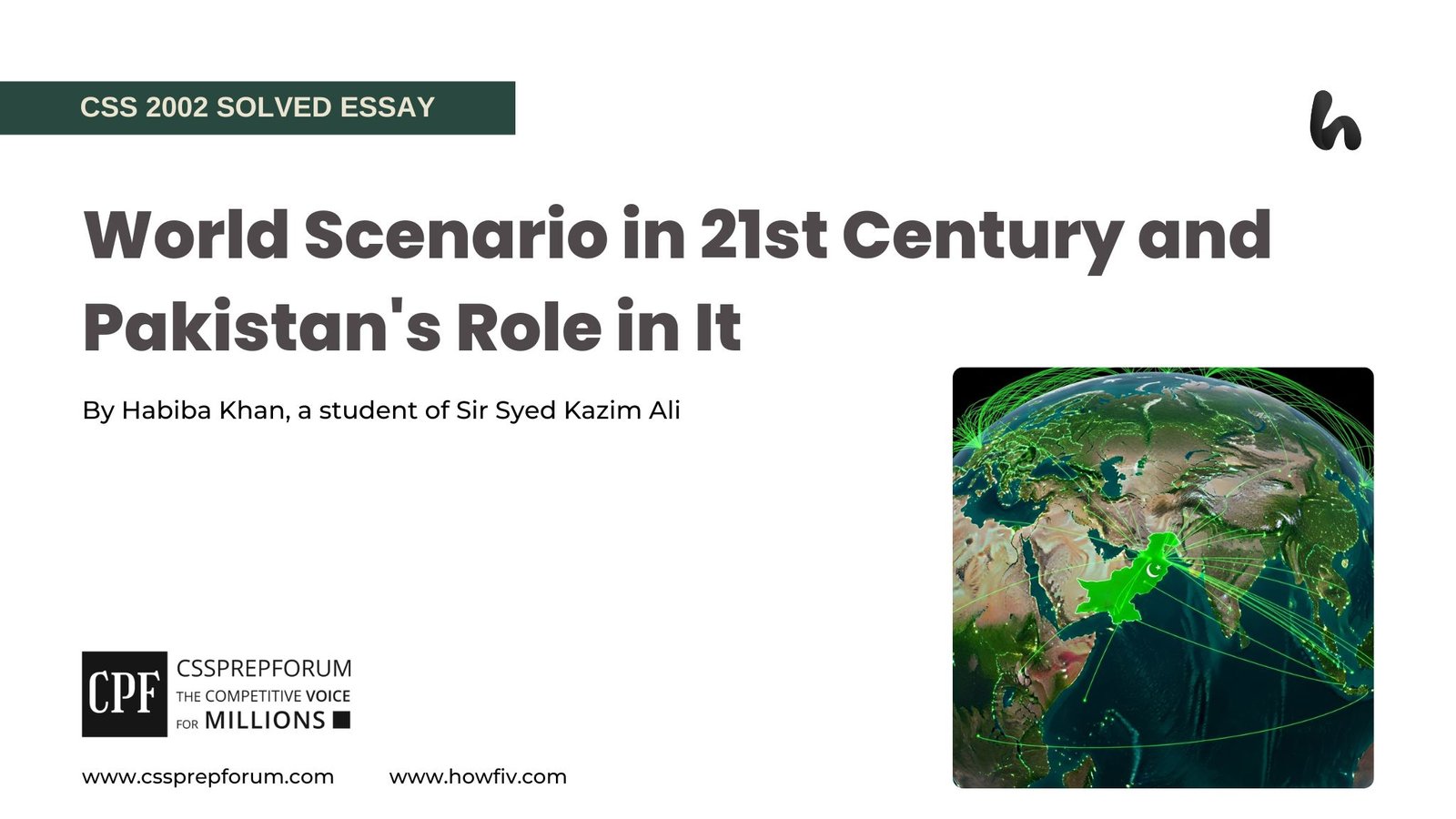Looking for the CSS 2025 essay “Reforestation As A Global Urgency”? Cssprepforum is Pakistan’s largest community with all CSS past paper essays and CSS solved essays. Continue reading!
Miss Iqra Ali (Pakistan’s GSA Top Coach), a student of Sir Syed Kazim Ali, has attempted the CSS 2025 essay “Reforestation As A Global Urgency” using Sir Kazim’s proven essay writing pattern and strategy. As Pakistan’s leading CSS and PMS English Essay and Precis coach, Sir Syed Kazim Ali has been the only English mentor with the highest success rate of his students in Essays and Precis for over a decade. The essay is uploaded to help other competitive aspirants learn and practice essay writing techniques and patterns to qualify for the essay paper.

Outline
Introduction
Although some opponents argue that large-scale reforestation is slow and economically impractical, the escalating climate crisis, biodiversity collapse, disruption of global water cycles, rising costs of natural disasters, and displacement of Indigenous communities make reforestation an urgent global priority requiring immediate intervention.
- The Significance of Forests in the Global Ecosystem
- Understanding Reforestation and Its Role in Environmental Stability
- The Current State of Global Deforestation
- According to the Forest Declaration Assessment 2024, 6.37 million hectares of deforestation occurred worldwide in 2023 alone.
Factors Making Reforestation a Global Urgency
Reforestation as an Environmental Urgency
- The Escalating Climate Crisis and Carbon Overload
- Evidence: The World Resources Institute states that deforestation accounts for 15per cent of global greenhouse gas emissions
- Biodiversity Collapse and Species Extinction
- Evidence: According to IPBES Global Assessment, one million species, including Spix’s Macaw and Zanzibar Leopard, have gone extinct due to deforestation
- Disruption of the Global Water Cycle
- Evidence: A study published in the Journal of Hydrology found that 42per cent of deforested areas led to a warmer, drier climate and reduced water yield
Reforestation as an Economic Urgency
- Increased Cost of Natural Disasters
- Evidence: Munich Reinsurance Company reports that natural disasters destroyed $280 billion worth of assets globally.
- Rising Food Prices and Agricultural Losses
- Evidence: Deforestation in Africa’s Congo Basin, Southeast Asia, and the Amazon threatens food production in major agricultural economies like the U.S., India, and China
- Decline in Eco-Tourism Revenue
- Evidence: Madagascar’s deforestation led to a 40per cent drop in eco-tourism revenue, impacting thousands of jobs
Reforestation as a Socio-Cultural Urgency
- Threat to Indigenous Communities and Cultural Erasure
- Evidence: Earth.org reports that deforestation threatens the Yanomami tribe in Brazil, the Penan tribe in Malaysia, and the Gond tribes in India
- Rising Air Pollution and Public Health Emergencies
- Evidence: The World Health Organization (WHO) estimates that air pollution, aggravated by deforestation, causes 7 million deaths annually
- Irreversible Damage for Future Generations
- Evidence: Scientists warn that once deforestation crosses ecological tipping points, recovery will be impossible, making parts of the planet uninhabitable by the end of the century
Counterarguments: Why Some Oppose Large-Scale Reforestation
- Counterargument-1: Reforestation takes too long, while technological solutions like carbon capture offer faster results
- Refutation: Assisted natural regeneration speeds up forest recovery (Chazdon & Guariguata, 2016)
- Counterargument-2: Reforestation Is Economically Impractical because large-scale reforestation is expensive, making alternative solutions more feasible
- Refutation: Short-term costs are outweighed by long-term benefits, including carbon credits and sustainable timber
Case Studies: The Global Impact of Reforestation
- China’s “Great Green Wall” Initiative
- Over 66 billion trees have been planted since the 1970s to combat desertification, and now Northern China has seen improvements in land fertility and climate stabilization
- Brazil’s Efforts in the Amazon Rainforest
- Policy changes and conservation programs reduced deforestation rates in the past decade, and sustainable farming and land management practices helped restore degraded land
Rational and Practical Solutions to Achieve Reforestation Targets
- Community-Based Reforestation Programs
- Corporate Responsibility and Carbon Offset Programs
- Government Policies and Global Cooperation
Conclusion

Forests are the planet’s lungs, absorbing carbon dioxide, regulating climate, and supporting biodiversity. However, rampant deforestation, driven by industrialization, agriculture, and urban expansion, has severely disrupted global ecosystems. According to the Forest Declaration Assessment 2024, the world lost 6.37 million hectares of forest in 2023 alone, exacerbating climate change, biodiversity loss, and natural disasters. Although some argue that large-scale reforestation is slow and economically unfeasible, the escalating climate crisis, collapsing water cycles, and rising costs of ecological degradation have made immediate action imperative. Indeed, reforestation is no longer an optional environmental initiative but a global necessity. It serves as a crucial solution to restoring ecological balance, mitigating natural disasters, and ensuring the survival of future generations. Therefore, governments, corporations, and individuals must act decisively to reverse deforestation before irreversible damage is done.
Before jumping toward understanding the reforestation process, understanding the significance of forests is essential. Indeed, forests are critical to the Earth’s ecological system, serving as carbon sinks, biodiversity reservoirs, and water cycle regulators. Truly, covering approximately 31 per cent of the planet’s land area, forests absorb carbon dioxide, mitigating climate change and reducing greenhouse gas concentrations. Additionally, they support nearly 80 per cent of terrestrial species, providing habitats for diverse flora and fauna. Furthermore, forests play a key role in maintaining global water cycles by regulating rainfall patterns and preventing soil erosion. However, large-scale deforestation is rapidly diminishing these benefits, leading to climate instability; biodiversity loss; and disruptions in freshwater availability. And the destruction of forests not only threatens ecosystems but also affects millions of people who rely on them for food, medicine, and economic stability. Given their fundamental role in sustaining life, forests thus remain vital for global environmental balance.
To fully grasp the urgency of reforestation, comprehending its role in maintaining environmental stability is widely critical. Reforestation, the process of restoring lost or degraded forests through natural regeneration or human-led efforts, is vital for reversing environmental damage caused by deforestation. Indeed, forests act as natural climate regulators by absorbing carbon dioxide, maintaining biodiversity, and preventing desertification. However, continuous deforestation has disrupted these functions, contributing to rising global temperatures and ecological instability. According to the Global Forest Resources Assessment, the world lost 4.7 million hectares of forest annually between 2010 and 2020, leading to significant biodiversity loss and increased carbon emissions. Moreover, the depletion of forests accelerates soil erosion, disrupts rainfall patterns, and weakens resilience to natural disasters. Given these impacts, reforestation hence plays a critical role in restoring environmental stability by replenishing lost forest cover, supporting wildlife habitats, and enhancing climate resilience.

Given forests’ vital role in maintaining environmental balance, the rapid depletion of global forest cover has become a pressing concern. Despite growing awareness of the importance of forests, deforestation continues at an alarming rate, driven by agricultural expansion, urbanization, and industrial activities. To fully comprehend the severity of the crisis, it is crucial to examine the current state of global deforestation and the scale at which forest loss occurs. Deforestation remains a significant global challenge, with millions of hectares of forest disappearing annually. According to the Forest Declaration Assessment 2024, approximately 6.37 million hectares of forest were lost worldwide in 2023 alone, highlighting human activities’ persistent and severe impact on natural ecosystems. Similarly, the Global Forest Resources Assessment (FAO) reports that between 2010 and 2020, the net global forest loss averaged 4.7 million hectares per year, primarily due to logging, agricultural expansion, and infrastructure development. These alarming statistics highlight the relentless pace at which forests are being cleared – leading to rising carbon emissions, biodiversity loss, and climate instability. Hence, without immediate intervention, continued deforestation threatens not only ecosystems but also the livelihoods of millions who depend on forests for survival.
Now that the environmental urgency has been established examining the factors that have made reforestation a global necessity is essential. One of the most pressing concerns is the escalating climate crisis driven by deforestation. In fact, forests function as natural carbon sinks, absorbing carbon dioxide and regulating atmospheric greenhouse gas levels. Nevertheless, widespread deforestation has disrupted this equilibrium, accelerated global warming and intensified extreme weather patterns. According to the World Resources Institute, deforestation contributes nearly 15per cent of global greenhouse gas emissions, making it a significant factor in climate change. As tree cover declines, carbon absorption capacity weakens – leading to increased temperature fluctuations, rising sea levels, and prolonged droughts. Thus, the continued loss of forests exacerbates climate instability, making reforestation an urgent necessity in the fight against environmental degradation.
Another critical factor highlighting the urgency of reforestation is the alarming rate of biodiversity collapse and species extinction caused by deforestation. Undoubtedly, forests act as habitats for nearly 80 per cent of terrestrial species, providing shelter; food; and breeding grounds essential for survival. Yet large-scale deforestation fragments ecosystems by isolating species and disrupts food chains, leading to severe population declines and extinction. According to the Intergovernmental Science-Policy Platform on Biodiversity and Ecosystem Services (IPBES) Global Assessment, nearly one million species, including the Spix’s Macaw and Zanzibar Leopard, have gone extinct due to deforestation. This rapid biodiversity loss destabilizes ecosystems, reducing their ability to recover from environmental changes and weakening global ecological resilience. And the disappearance of species affects human survival, as many medicinal plants, pollinators, and keystone species that regulate ecosystems are being lost. As deforestation continues, the threat to biodiversity intensifies, thus making reforestation essential in preserving ecological balance.
Moreover, the major consequence of deforestation that underscores the urgency of reforestation is the disruption of the global water cycle. Undeniably, forests play a crucial role in maintaining hydrological balance by regulating rainfall patterns, absorbing groundwater, and preventing excessive evaporation. Nonetheless, large-scale deforestation weakens these processes, leading to erratic rainfall, prolonged droughts, and declining freshwater availability. A study published in the Journal of Hydrology found that 42 per cent of deforested areas experienced a shift toward a warmer, drier climate with significantly reduced water yield. This disruption threatens agricultural productivity, increases the risk of desertification, and intensifies water scarcity, particularly in regions already vulnerable to droughts. Additionally, tree cover loss accelerates soil erosion, leading to river sedimentation and further diminishing freshwater resources. As deforestation continues, these water cycle disruptions would only worsen, making reforestation critical for restoring global water stability.
Beyond its environmental consequences, deforestation has significant economic implications, particularly in exacerbating the financial burden of natural disasters. Truly, forests act as natural barriers against extreme weather events by stabilizing soil, preventing floods, and reducing the intensity of storms. But deforestation increases the vulnerability of landscapes to disasters such as hurricanes, landslides, and wildfires, leading to devastating economic losses. According to Munich Reinsurance Company, natural disasters destroyed $280 billion worth of assets globally. Th is destruction of infrastructure, loss of agricultural productivity, and rising disaster recovery costs immensely strain economies, particularly in developing nations that lack the resources to mitigate such damages. As deforestation accelerates the frequency and severity of natural disasters, the financial cost of inaction hence grows, making reforestation a crucial strategy for reducing economic vulnerability.
Besides, the pressing economic consequence of deforestation is its impact on global food production. As forests are vital in maintaining soil fertility, regulating local climates, and ensuring stable rainfall patterns – all of which are essential for agriculture – widespread deforestation disrupts these ecological processes, leading to reduced crop yields, soil degradation, and unpredictable weather conditions that threaten food security. For instance, deforestation in Africa’s Congo Basin, Southeast Asia, and the Amazon poses a substantial risk to food production in major agricultural economies like the United States (US), India, and China. It means that the loss of forest cover has already contributed to prolonged droughts, floods, and declining soil health, making farming increasingly difficult and expensive. As food supply decreases, prices rise, disproportionately affecting lower-income populations and intensifying global hunger. Therefore, given these economic risks, reforestation is essential to safeguarding agricultural productivity and food stability.
Additionally, deforestation also leads to economic losses by undermining the eco-tourism industry, which relies on thriving natural landscapes and biodiversity. Unquestionably, many regions depend on forests and wildlife attractions to generate revenue, create jobs, and support local economies. However, as forests are destroyed, the loss of wildlife habitats and scenic landscapes diminishes tourist interest, resulting in declining revenues. For example, in Madagascar, deforestation has led to a 40 per cent drop in eco-tourism revenue, directly impacting thousands of jobs. The destruction of natural attractions not only affects businesses reliant on tourism but also reduces government earnings that could otherwise fund conservation and development programs. Thus, without urgent reforestation efforts, nations that depend on eco-tourism would continue to experience financial setbacks, worsening unemployment and economic instability.
Moreover, deforestation not only endangers the environment and economy but also poses a serious threat to Indigenous communities and their cultural heritage. For centuries, Indigenous tribes have lived in harmony with forests – relying on them for food, shelter, medicine, and spiritual practices. However, large-scale deforestation displaces these communities, strips them of their traditional way of life, and erases invaluable cultural knowledge. According to Earth.org, deforestation threatens the survival of the Yanomami tribe in Brazil, the Penan tribe in Malaysia, and the Gond tribes in India. As forests disappear, Indigenous groups lose their ancestral lands, leading to forced migration; economic hardship; and social marginalization. Furthermore, their deep ecological knowledge – crucial for sustainable environmental practices – is lost. So, protecting forests through reforestation is vital not only for ecological balance but also for preserving Indigenous identities, traditions, and rights.
Furthermore, deforestation significantly worsens air pollution, leading to severe public health crises worldwide. Indeed, trees play a crucial role in filtering air pollutants by absorbing carbon dioxide and releasing oxygen. However, large-scale deforestation reduces air purification capacity, allowing pollutants to accumulate in the atmosphere. Burning forests, a common practice in deforested areas, further releases harmful particulate matter and toxic gases, aggravating respiratory diseases and other health issues. And the World Health Organization (WHO) also estimates that air pollution, aggravated by deforestation, causes 7 million deaths annually. This highlights that prolonged exposure to polluted air increases cases of asthma, lung cancer, and cardiovascular diseases – particularly in urban areas. Without urgent reforestation efforts to restore air quality, millions more would suffer from preventable health conditions, placing an enormous burden on healthcare systems worldwide.
Beyond immediate consequences, deforestation also threatens the long-term survival of future generations by pushing ecosystems toward irreversible collapse. Researchers emphasize that ecosystems have critical tipping points beyond which recovery becomes impossible, resulting in irreversible environmental degradation. In addition, the destruction of rainforests, which act as the planet’s lungs, accelerates global warming and biodiversity loss, making vast regions uninhabitable. Considering all these concerns, scientists warn that recovery would be impossible once deforestation crosses ecological tipping points, making parts of the planet uninhabitable by the end of the century. If deforestation continues at its current pace, future generations would inherit a world plagued by extreme climate conditions, food and water shortages, and the loss of vital natural resources. Hence, addressing deforestation through large-scale reforestation efforts is crucial to ensuring a livable planet for coming generations.
However, some argue that large-scale reforestation is an ineffective solution because it takes decades to produce meaningful results. In contrast, technological solutions, such as carbon capture and geo-engineering, offer faster ways to mitigate climate change. They claim that given the urgency of the climate crisis, investing in rapid technological solutions is a more practical approach than waiting for forests to regrow. However, this argument overlooks the advancements in reforestation techniques that accelerate forest recovery. According to Chazdon & Guariguata (2016), assisted natural regeneration significantly speeds up reforestation efforts. Additionally, the Miyawaki Method has been proven to restore forests in 20–30 years instead of the centuries it typically takes for natural regrowth. While technology plays a role in climate solutions, prioritizing reforestation remains essential as it provides multiple environmental benefits beyond carbon sequestration, including biodiversity restoration and water cycle regulation.
Another common argument against large-scale reforestation is that it is too expensive, making it an impractical solution compared to other environmental initiatives. Critics suggest governments and businesses should focus on more cost-effective alternatives, such as renewable energy or industrial carbon capture, rather than investing in large-scale tree-planting projects. However, this perspective fails to consider the long-term economic benefits of reforestation. While initial costs may be high, the long-term advantages, such as carbon credits, sustainable timber production, and reduced disaster recovery expenses, far outweigh the investment. Professor Tom Crowther of Eidgenössische Technische Hochschule Zürich (ETH Zurich) states, “Reforestation is available now; it is the cheapest solution, and everyone can participate.” Thus, this demonstrates that reforestation is feasible and one of the most accessible and sustainable climate solutions.
Stepping ahead, one of the most ambitious reforestation efforts in the world is China’s “Great Green Wall” initiative, which aims to combat desertification and restore ecological balance. Since the 1970s, China has planted over 66 billion trees across its arid northern regions, particularly in areas threatened by desert expansion, such as the Gobi Desert. This large-scale afforestation project has helped stabilize soil, reduce sandstorms, and improve local climate conditions. Additionally, the initiative has contributed to increased land fertility, allowing for better agricultural productivity and ecosystem recovery. While challenges remain, such as ensuring long-term tree survival and biodiversity conservation, China’s reforestation efforts demonstrate how large-scale planting initiatives can mitigate environmental damage and contribute to climate resilience. Therefore, the success of this project highlights reforestation as a viable solution to environmental degradation.
Similarly, Brazil, home to the Amazon Rainforest, has faced severe deforestation due to logging, agricultural expansion, and illegal land clearing. However, the Brazilian government and environmental organizations have implemented policy changes and conservation programs to reduce deforestation rates in the past decade. Measures, such as stricter enforcement of environmental laws, protected land designations, and incentives for sustainable farming, have significantly slowed the destruction of the Amazon. Additionally, reforestation projects focusing on degraded land restoration have helped bring back forest cover in some regions. Moreover, sustainable farming techniques, such as agroforestry, have successfully allowed economic growth while preserving forest ecosystems. These efforts show that deforestation can be reversed with proper policies and land management strategies, thereby reinforcing the urgent need for global reforestation initiatives.
Having established the urgency of reforestation, exploring rational and practical solutions to achieve reforestation targets is essential. One of the most effective ways to achieve large-scale reforestation is through community-driven initiatives that involve local populations in conservation efforts. Indeed, community-based reforestation programs empower individuals by providing education, resources, and incentives to restore forests. A notable example is Kenya’s Green Belt Movement, founded by Wangari Maathai, which has successfully planted over 50 million trees. This initiative not only contributes to environmental restoration but also supports local economies by creating jobs and promoting sustainable agricultural practices. When communities are directly involved in reforestation, tree survival rates increase, and long-term forest management becomes more sustainable. So, encouraging similar grassroots movements worldwide can significantly enhance reforestation efforts while fostering a sense of environmental responsibility among local populations.
Next, corporations play a crucial role in reforestation efforts by integrating environmental sustainability into their business strategies. Many companies are now committing to carbon offset programs, funding large-scale afforestation projects to counterbalance their carbon emissions. For example, Microsoft and Amazon have pledged significant investments in afforestation initiatives to reduce their environmental footprint. These programs not only help restore degraded land but also encourage corporate accountability in mitigating climate change. And by investing in reforestation, businesses can contribute to global carbon reduction goals while enhancing their corporate social responsibility image. Therefore, expanding corporate-backed tree-planting projects – coupled with strict environmental regulations – can accelerate global reforestation efforts and make them more financially viable.
Finally, effective reforestation requires strong government policies and international collaboration to ensure long-term success. To do so, governments must implement legislation that protects existing forests while promoting large-scale reforestation initiatives. For instance, Norway pledged $1 billion to support Amazon rainforest restoration, providing financial aid to conservation programs. Additionally, policies, such as Reducing Emissions from Deforestation and Forest Degradation (REDD+), offer financial incentives for developing nations to preserve their forests. Likewise, strengthening global cooperation between governments, environmental organizations, and businesses can enhance reforestation efforts by providing necessary funding; research; and legal frameworks. Hence, a coordinated international effort is essential to combat deforestation at a scale required to effectively address climate change and ecological degradation.
In conclusion, reforestation is no longer an option but a global necessity, as it remains one of the most effective solutions for combating climate change, restoring biodiversity, and maintaining ecological stability. And the alarming rate of deforestation has exacerbated environmental crises, increased economic vulnerabilities due to natural disasters, and threatened the livelihoods of Indigenous communities. So, without immediate and large-scale reforestation efforts, the world risks crossing irreversible ecological tipping points. Therefore, governments must implement stricter conservation policies, corporations should invest in sustainable afforestation projects, and individuals must actively support reforestation initiatives. Only through collective action can forest restoration be achieved, thus ensuring a healthier planet for future generations. And the time to act is now before the damage becomes permanent.
CSS 2025 Solved Essays!
Interested in learning all the CSS 2025 Solved Essays? Click on any to continue reading. Each essay is meticulously attempted by Sir Syed Kazim Ali’s students, who have either qualified for CSS or PMS or secured the highest marks in the essay paper.
| Patriotism is supporting your country all the time, and your government when it deserves it |
| Brains, like hearts, go where they are appreciated |
| Reforestation as a Global Urgency |
| Hamas-Israel Conflict: A Test Case for World Conscience |
| Rich in politicians, we desperately need statesmen |
| True peace is not merely the absence of tension; it is the presence of justice |
| To reign is worth ambition though in Hell |
| Frailty is no more the name of Woman |
| Dynastic politics is the worst mockery of democracy |
| An investment in knowledge pays the best interest |

CSS Solved Past Papers’ Essays
Looking for the last ten years of CSS and PMS Solved Essays and want to know how Sir Kazim’s students write and score the highest marks in the essays’ papers? Then, click on the CSS Solved Essays to start reading them.
CSS Solved Essays
CSS Solved General Science & Ability Past Papers
Want to read the last ten years’ General Science & Ability Solved Past Papers to learn how to attempt them and to score high? Let’s click on the link below to read them all freely. All past papers have been solved by Miss Iqra Ali & Sir Ammar Hashmi, Pakistan’s top CSS GSA coach having the highest score of their students.












